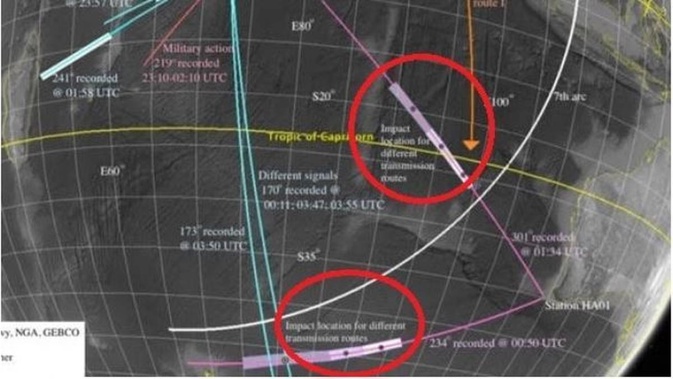
It remains one of the greatest aviation mysteries of all time but now a mathematician says he has a new theory on where MH370 went down.
The whereabouts of doomed flight MH370 remains one of the greatest aviation mysteries of all time.
But a mathematician from Cardiff University in Wales believes he's calculated a "new impact location" where the doomed Malaysian Airlines aircraft went down in 2014 with 239 people on board.
Writing for The Conversation, Dr Usama Kadri — a lecturer in applied mathematics and engineering — focused his argument for the new impact zone based on "acoustic waves".
Dr Kadri, whose work focuses on physical oceanography, quantum analogs, multiphase flows and wave power harnessing, said he and his team of researchers have been able to identify two locations where the aeroplane could have impacted with the ocean, as well as an alternative route that it may have taken on March 8, 2014.
One theory puts the crash site further north in the Indian Ocean than previously believed, while the other points to a flight course taking MH370 closer to Madagascar.
/arc-anglerfish-syd-prod-nzme.s3.amazonaws.com/public/56ALVB27ONHEBO43RYQABKIRHE.jpg)
Map of hydrophone signals recorded on March 7 and 8, 2014, which may indicate a new location for MH370. Photo / Usama Kadri / Supplied
Dr Kadri's argument lies around waves — both outside and inside the water — and the distorted noise caused by nearby military action. He also questions 25 minutes of "missing" data recordings which were made at a secret US defence facility.
"When you drop a pebble in a lake, water waves are generated from the location of the impact, while sound waves create the splashing noise you hear," he wrote in the article. "Another type of wave is generated inside the water too: hydroacoustic. Similar to a sound wave, hydroacoustic waves move relatively slowly through the dense water, at 1500 metres per second (m/s)."
Typically, when an object hits water, surface waves tend to become smaller and smaller until we can't see them anymore. But, they do keep travelling through the water at a lower depth. These "acoustic-gravity waves" can travel for thousands of kilometres undisturbed, and even cross an entire ocean.
As for a plane, like MH370, the impact is "violent at the surface" of an ocean, meaning it "generates large surface waves, and a family of sound waves that come from a sudden change in pressure known as acoustic-gravity waves".
"These can travel thousands of kilometres through the water, carrying vital information on the source of the impact, before dissipating," he said.
/arc-anglerfish-syd-prod-nzme.s3.amazonaws.com/public/7V4UC7KKYZFRJOMCFLQI3NNRH4.jpg)
An image representing a theory that MH370 crashed in the northwest Indian Ocean, based on satellite data. Photo / Supplied
In 2017, Dr Kadri along with his colleague Dr Davide Crivelli, "looked at acoustic-gravity waves picked up by hydrophone (underwater microphone) stations in the Indian Ocean, to narrow down where flight MH370 may have impacted the ocean to two points".
But their new study has revealed another factor that may prove crucial for pinning down the location of the impact. And that factor is sea floor elasticity.
"The acoustic-gravity waves that we analysed for both this and our previous study came from two hydroacoustic stations (each of which has three underwater microphones called hydrophones), which were active at the time when MH370 went missing," he said.
"The first, HA01, is off Cape Leeuwin, Western Australia, while the second, known as HA08s, is at Diego Garcia, which is part of the Chagos Archipelago.
"Previous studies have mostly looked at the signals collected by station HA01, as well as signals that related to the last satellite data transmission from MH370. However, with our new understanding of acoustic-gravity waves we decided to look at hydroacoustic data from HA01 that was recorded during a wider time frame … and analysed data from the further away HA08s station too.
"Allowing for the effects of sea floor elasticity, the signal locations that we had previously identified using data from HA01 were now different."
While the Cape Leeuwin recordings (HA01) were relatively clear, those from Diego Garcia (HA08s) had been distorted by the noise of a nearby military exercise. This made extracting sound potentially related to MH370 from the recorded data much more difficult.
The distorted recording from HA08 was positioned at the secret US defence facility at Diego Garcia, in the heart of the Indian Ocean. Much of its data from the relevant time frame is distorted. And 25 minutes of it is inexplicably missing, according to Dr Kadri.
"Unfortunately, on top of the noisy recorded signals, 25 minutes of data from HA08s is missing," Kadri says.
"The signals we have analysed indicate that the there was a 25-minute shutdown that has gone unexplained by the Comprehensive Nuclear-Test-Ban Treaty Organisation, which is responsible for the hydrophone stations."
Dr Kadri says aligning what they had of HA08 with the recorded data from HA01 produced a new possible impact point.
"Although the proposed route and point of impact is distant from the 7th arc, we still recommend further studying a number of signals from HA08," he said.
"The bearings of some of these signals fall within the area where signals from the military action were picked up, so it is possible that the signals are associated with the military action."
But if the signals are related to MH370, this would suggest a new possible impact location in the northern part of the Indian Ocean.
/arc-anglerfish-syd-prod-nzme.s3.amazonaws.com/public/V4RADBVZ7VHKBAD3UKHM3JJJCM.jpg)
The expanded MH370 search zone. Photo / Supplied
Earlier this month, a fisherman by the name of Rusli Khusmin said his crew witnessed the disaster on March 8, 2014, watching the Malaysia Airlines flight with 239 people on board "move like a broken kite".
The 42-year-old said there was no noise, just smoke, and he recorded the coordinates of the exact location the plane went into the water.
Mr Khusmin has pinpointed a location in the Sumatran Sea between Malaysia and Indonesia and has sworn on the Koran that he is telling the truth.
"I saw the plane moving from left to right like a broken kite," he said at a news conference in Subang Jaya, near Kuala Lumpur.
"There was no noise, just black smoke as a result of fires before it crashed into the water."
Last month an engineer at a top Danish university claimed investigators had been looking in the wrong place.
He came up with a possible new flight plan that conforms with existing data, and it looks nothing like those that guided search efforts before.
It puts MH370's probable crash site off Christmas Island, south of Jakarta. And he speculates the missing aircraft's new possible track means a hijacker could have 'bailed out'.
More than 30 bits of aircraft debris have been collected from various places around the world but only three wing fragments that washed up along the Indian Ocean have been confirmed to be from MH370.
Last year a senior aviation figure said it was time the Australian Transport Safety Bureau abandon its version of events.
Captain Mike Keane, a former chief pilot of Britain's largest airline easyJet, claimed the ATSB was complicit to a crime if it stuck to its "ghost flight" theory that the plane was on autopilot when the pilots were incapacitated at the end of the flight when it crashed.
Many experts believe MH370 was used in a murder-suicide mission by Captain Zaharie Ahmad Shah.
— with Jamie Seidel and Stephanie Bedo
Take your Radio, Podcasts and Music with you









